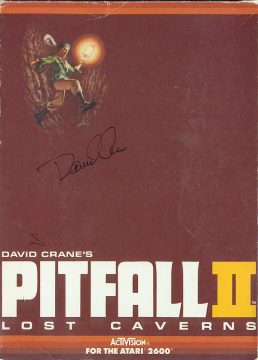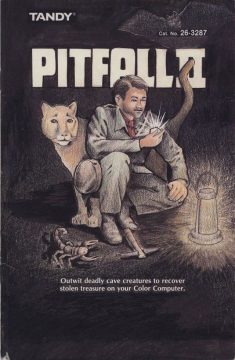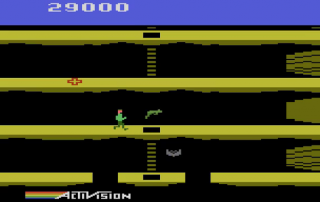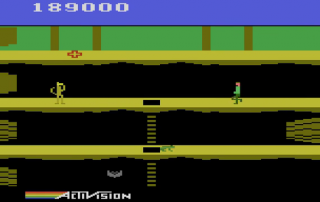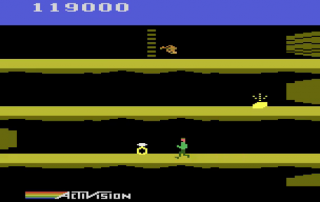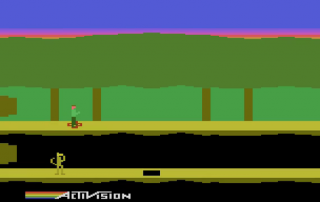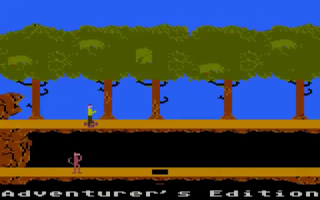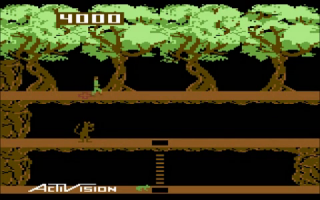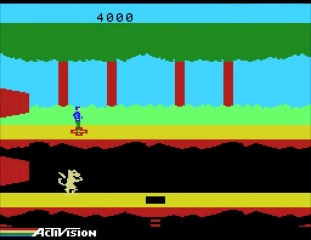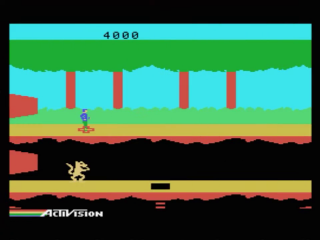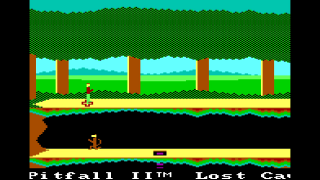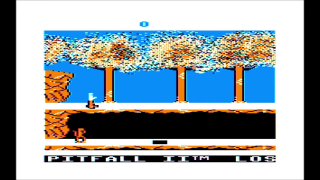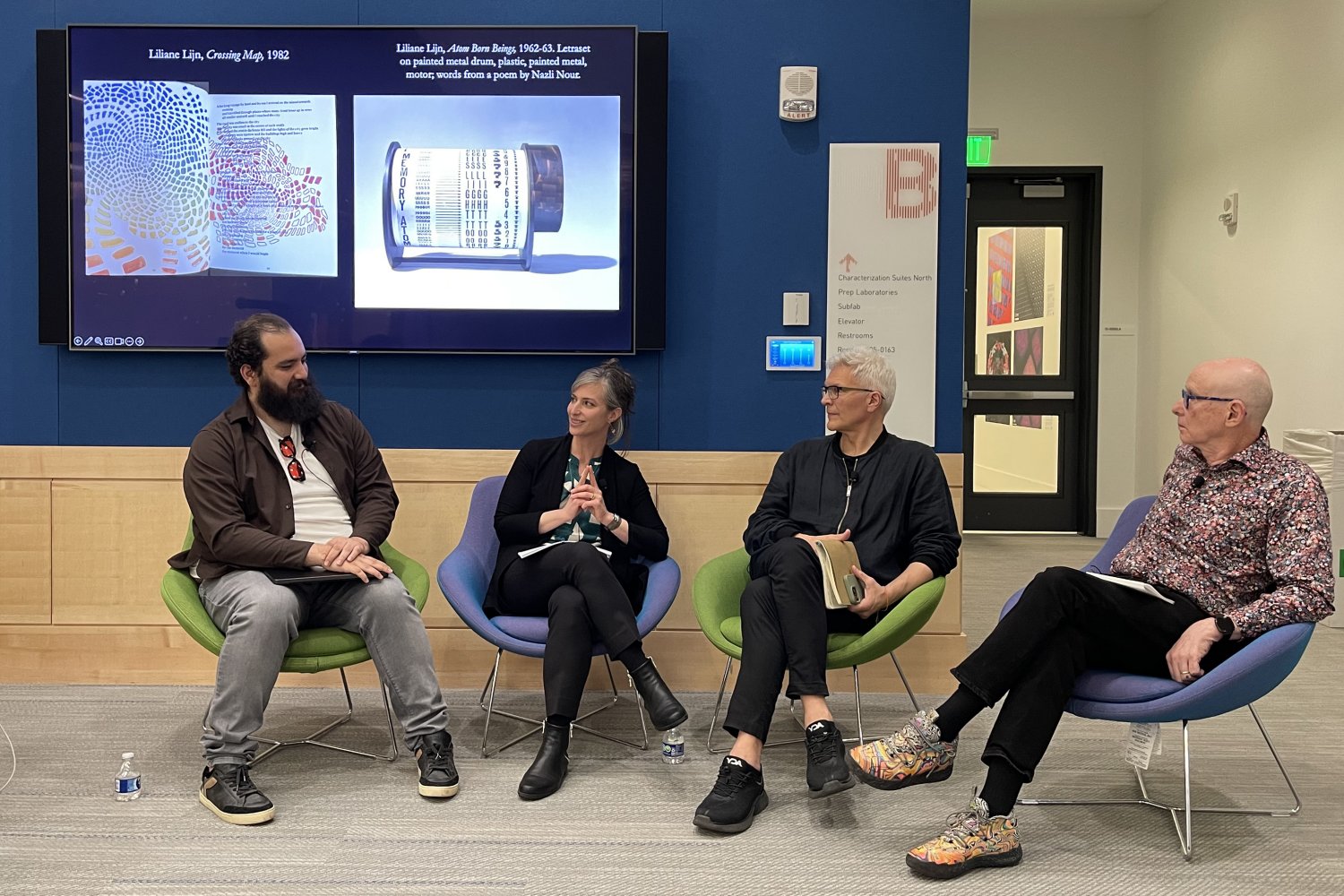Pitfall II: Lost Caverns
This entry is part 2 of 2 in the series Pitfall!
Fans of Pitfall! didn’t have to wait long for a sequel, as Pitfall II: Lost Caverns was released for the Atari 2600 in 1984. Unlike the original’s timed quest to find treasure in the deep jungle, Pitfall II took place inside a huge maze of caverns. Harry also had a new goal: rescue Rhonda and Quickclaw, who returned from the Saturday Supercade cartoon, and locate the Raj Diamond. Accomplishing those things in any order will complete the game. An extra bonus point item is the prehistoric cave rat. This rat can only be approached from behind. If approached from the front, it will push Harry right back into the screen he just came from. This is particularly aggravating, as it’s guarding Quickclaw, meaning you have to find another, less direct route to reach him.
As so much has been changed from the first game, the majority of the obstacles from it are gone. Instead, now Harry had to avoid bats, condors, electric eels, poison arrow frogs and the lone returning creature from Pitfall! – scorpions. The bats and condors have preset flight paths, so it’s just a matter of timing to make it past them. The poison arrow frogs just jump back and forth over ladders. They move slowly enough that if you’re not careful, a bat on the next level can get Harry while you’re waiting for the frog to jump. The scorpions just walk back and forth, always heading in Harry’s direction. This is frustrating when you’re climbing a ladder above or below a floor with a scorpion, because once it detects Harry’s presence, it will park itself right underneath or above Harry and not move from that spot unless you move far enough away from it in the opposite direction. The electric eels inhabit the underground rivers in the caverns. As Harry’s only new skill is the ability to swim, that makes the rivers extra dangerous. However, the eels usually swim close to the surface of the water, so if you can get under them, Harry will be all right.
At one point, you’ll reach the lowest point in the caverns and not see a way to proceed, at first. That’s usually when a red and blue striped balloon lazily floats through the air in Harry’s direction. Jump up and grab it, and Harry will start to fly upwards. There are still bats flying across the cavern, and a collision with one of them will pop the balloon, sending Harry plummeting straight down. Collide with the ceiling in the wrong place, and the same thing happens. With skillful timing and maneuvering, you can pop the balloon and explore the side caverns, where more often than not, you’ll find gold bars. These are scattered all throughout the caverns, almost right from the starting screen, but there’s a lot of them in the side caverns.
Then there’s what look like red crosses. These in particular are important. The timer and lives from the first game have also been removed, which means Harry just has one life. However, if he’s touched by any enemy, he’ll be sent back to the previous red cross he touched. There’s literally no way to die in Pitfall II. This alone makes it easier than the original Pitfall!, but it does get frustrating if you keep getting hit before you reach the next red cross and keep having to replay the same section, especially since as you’re traveling back to the previous red cross, your score is being drained. Regarding his choice to switch from lives to the red cross system, David Crane stated in an interview for the book Digital Archaeology: Retrogaming Recollections (2024, Lulu): “While designing the game, I realized that it was going to be a much longer adventure than Pitfall!, and that I would either have to give more lives or come up with something new. The red crosses were the first ‘game save way points’ in a video game.”
Crane also wanted to do something to show that the 2600 could compete with newer consoles: “By the time I was ready to make a sequel to Pitfall!, the Atari 2600 had lasted almost 10 years in the market—well past Atari’s expectations. With new systems coming out, I felt that the 2600 needed a face lift in order to compete. While on vacation (watching the U.S. Open Tennis Tournament), I designed a supplemental integrated circuit to go in the cartridge and expand the 2600’s capabilities. This chip expanded the graphic abilities of the system, as well as added harmonic music. Pitfall II became the first (and last) game to use this more expensive cartridge. I used the new capabilities to allow for more detailed screens in the game.”
As a result of the Display Processor Chip, Pitfall II became the first home video game to have a soundtrack, which mainly consisted of the theme song to the Pitfall! cartoon from Saturday Supercade. Crane went on to say: “The first time I had Harry die and fly back to the last way point, the music was much too upbeat for the mood. I was trained in music as well as art, so I composed a minor-key version of the theme song that conveyed the sad emotion of failure. As it turns out, that was the first time music was used in a video game to convey a mood. Inventions like those were common in the early days of video games. In many cases we were the first to tread new ground, so we had to innovate every day. It was a great time to be a part of history.”
Regarding the inclusion of the classical music piece “Sobre las Olas,” which plays when Harry grabs a balloon and begins floating upward, Crane had this to say: “The funniest story from the development of Pitfall II concerned the flying music. In the game, once Harry reaches the underground river at the bottom of the cavern he finds helium-filled balloons to grab (don’t ask me why… it’s only a video game). Once he grabs a balloon, the music that is played (which I arranged from memory) is circus music that might accompany a trapeze act. As the game was about to be released, someone asked ‘Is that public domain? Do we have to license the music?’
In a panic, our licensing department started calling music agents in Hollywood. With nothing else to go on they hummed and sang the tune into answering machines all over Los Angeles. After a couple days with no results they told me about this. Yes, I laughed at them and told them to keep at it. That night I was telling this funny story from work to my wife, a classically-trained pianist with a music minor from Stanford. She said, ‘Are you kidding? That song is called ‘Over the Waves’ (‘Sobre las Olas’ in its original Spanish) composed by Juventino Rosas.’ She then stepped over to her music cabinet and pulled out the sheet music to give to the licensing guys for a copyright search.
It always pays to ask the wife!”
The Raj Diamond is hidden in a side cavern, which makes it one of the most difficult things to find in the game. Once you’ve managed to get it, Rhonda and Quickclaw (and the cave rat, if you remember to do so), PItfall will jump up and down several times, then stop. The game is over.
Of course, Pitfall II received a lot of ports, more so than the original game. The Commodore 64 port looks significantly improved over the 2600 original, with much more detail in the backgrounds, but for some reason it’s much darker than the original. It also sounds very nice. In comparison, the ZX Spectrum port looks absolutely horrible, with monochrome graphics, virtually nothing in the way of backgrounds, and vaguely stick figure-esque characters. On top of that, the collision detection is way off, making it virtually impossible to dodge some hazards, and the one melodious music has been reduced to a scratchy, repetitive theme that plays way too fast. The Colecovision and MSX ports are again, nearly identical. Several of the character sprites have been redrawn, including Harry, but the backgrounds look almost exactly like the 2600 original. But it plays quite well. The TRS-80 port is a horrible mess. It plays too slowly, there’s no music at all, and everything is presented in three colors: red, white and blue (mostly white). The Apple II port is marginally better. It runs faster, there’s music, and there’s even two additional colors, black and green, on display. However, there’s a horrible tromping sound made when Harry runs. It’s supposed to be footsteps, but it’s just annoying. The IBM PCjr port looks nice and plays fine, but some of the color choices are questionable, at best. Brown scorpions? Purple ladders? On the plus side, the bats now have red eyes and the balloons are much more detailed, and Quickclaw actually runs back and forth, instead of standing there shaking, which he did in every other version. The 2600 original was included in two Activision compilations, Activision Anthology (PS2) and Activision Hits Remixed (PSP), and was also included as a bonus in Pitfall: The Lost Expedition (GC/PS2/XBX/GBA/WIN) & Call of Duty: WWII. It was also released for Microsoft’s Game Room service.
The 5200/Atari 8-bit version has a lot of background changes (more realistic looking trees and boulders, among them), but it also has something that the other ports don’t.
– The Adventurer’s Edition –
When Pitfall II was released for the Atari 5200 and Atari 8-bit line, Mike Lorenzen had handled the porting duties, as Crane was deep in development of other games by then. At the same time, it was being ported to the Commodore 64 by Tim Shotter. According to Crane, “The two projects proceeded at different rates. The C-64 version showed daily progress—background, screen, characters, etc. Mike hammered on the 800 version for weeks, translating the code and taking care not to affect any game logic. The 800 version always looked like it was behind.
Lo and behold, the games reached Beta on the same day, and then came the surprise. The C64 version had to go through an entire normal two month QA process, fixing bugs that occurred during from-scratch development. The 800 code was bug free! It played exactly as the original because it used the game play logic right out of the original 2600 game. In fact, if there were game logic bugs in the 2600 version, they probably existed in the 800 version.
Marketing wanted to release the two versions simultaneously, so while Tim was going through a completely natural debug phase, Mike had time to design and implement an entirely new game world that unlocked when you finished the first. This taught us a valuable lesson regarding which porting method was best, at least for assembly-language code.”
The “new game world,” as Crane described it, was a new set of caverns, complete with new creatures, new pitfalls (pun not intended) and a new objective: escape the Lost Caverns. Jumping into the fray are rabid bats (that have unpredictable flight patterns), speedy fire ants, and piranha. The platforms are all scrambled: some of them are only wide enough for Harry, which makes it difficult to dodge anything flying your way, and some don’t connect to any ladders, forcing you to fall or find another alternate way to get onto them. Instead of gathering treasures, you have to pick up items belonging to a snake charmer and bring them to him. Once he has all of them, he’ll play a tune that causes a rope to rise out of a basket, at which point you see Harry, Rhonda and Quickclaw given a ride to the surface, along with the Raj Diamond, as they finally escape the Lost Caverns.
Harry was far from done with the Lost Caverns, as it turned out.
Screenshot Comparisons
